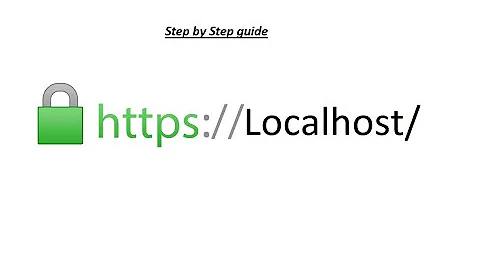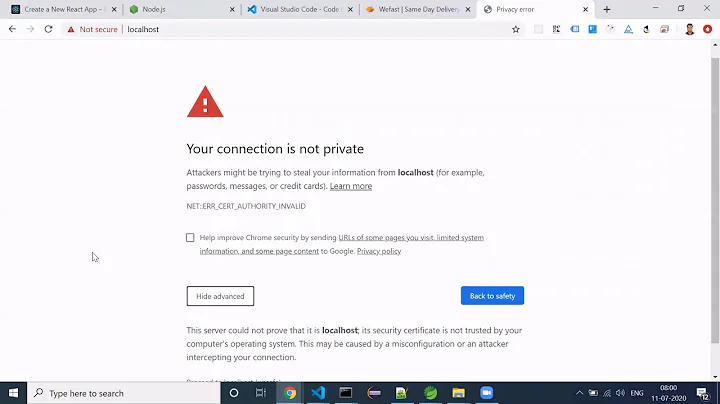SSL23_GET_SERVER_HELLO:unknown protocol when trying to access HTTPS URL
30,095
Solution 1
My bad, I had ssl.conf in /etc/apache2 instead of /etc/apache2/sites-enabled
after moving the file and restarting apache2 service apache2 restart it all worked fine.
Solution 2
In my case I had not enabled the site 'default-ssl'. Only '000-default' was listed in the /etc/apache2/sites-enabled folder.
Enable SSL site on Ubuntu 14 LTS, Apache 2.4.7:
a2ensite default-ssl
service apache2 reload
Related videos on Youtube
Author by
zabumba
Updated on September 18, 2022Comments
-
zabumba over 1 year
While trying to create a staging environment for my WORDPRESS website, I am not quite able to setup the HTTPS configuration.
I copied the wordpress folder and backed up Mysql database and was able to have a copy of my website, but whenever I click on any link, it will take me to HTTPS url and shows me a
SSL connection error.Environment
- Vagrant VM Ubuntu server
Precise64 - Chef to configure my host
- Apache2 w/ SSL mod
- Wordpress
UNAME
uname -a Linux test-www 3.5.0-23-generic #35~precise1-Ubuntu SMP Fri Jan 25 17:13:26 UTC 2013 x86_64 x86_64 x86_64 GNU/LinuxSSL Configuration
vagrant@test-www:/etc/apache2$ more ssl.conf <VirtualHost 192.168.33.10:443> DocumentRoot /var/www ServerName test-www.domain.com ErrorLog /var/log/apache2/error_secure.log LogLevel info SSLEngine on SSLCertificateFile /etc/ssl/wildcard.domain.com/certificate.crt SSLCertificateKeyFile /etc/ssl/wildcard.domain.com/server.key SSLCACertificateFile /etc/ssl/wildcard.domain.com/test-www.domain.com.ca.crt </VirtualHost>OPENSSL
vagrant@test-www:/etc/apache2$ openssl s_client -connect 192.168.33.10:443 CONNECTED(00000003) 139816269579936:error:140770FC:SSL routines:SSL23_GET_SERVER_HELLO:unknown protocol:s23_clnt.c:757: --- no peer certificate available --- No client certificate CA names sent --- SSL handshake has read 7 bytes and written 213 bytes --- New, (NONE), Cipher is (NONE) Secure Renegotiation IS NOT supported Compression: NONE Expansion: NONE ---WGET HTTP:443
vagrant@test-www:/etc/apache2$ wget http://192.168.33.10:443 --2015-02-02 17:24:31-- http://192.168.33.10:443/ Connecting to 192.168.33.10:443... connected. HTTP request sent, awaiting response... 404 Not Found 2015-02-02 17:24:31 ERROR 404: Not Found.WGET HTTPS
vagrant@test-www:/etc/apache2$ wget https://192.168.33.10 --2015-02-02 17:25:23-- https://192.168.33.10/ Connecting to 192.168.33.10:443... connected. OpenSSL: error:140770FC:SSL routines:SSL23_GET_SERVER_HELLO:unknown protocol Unable to establish SSL connection. vagrant@test-www:/etc/apache2$APACHE2.CONF
# # Generated by Chef # # Based on the Ubuntu apache2.conf ServerRoot "/etc/apache2" # # The accept serialization lock file MUST BE STORED ON A LOCAL DISK. # LockFile /var/lock/apache2/accept.lock # # PidFile: The file in which the server should record its process # identification number when it starts. # PidFile /var/run/apache2.pid # # Timeout: The number of seconds before receives and sends time out. # Timeout 300 # # KeepAlive: Whether or not to allow persistent connections (more than # one request per connection). Set to "Off" to deactivate. # KeepAlive On # # MaxKeepAliveRequests: The maximum number of requests to allow # during a persistent connection. Set to 0 to allow an unlimited amount. # We recommend you leave this number high, for maximum performance. # MaxKeepAliveRequests 100 # # KeepAliveTimeout: Number of seconds to wait for the next request from the # same client on the same connection. # KeepAliveTimeout 5 ## ## Server-Pool Size Regulation (MPM specific) ## # prefork MPM # StartServers: number of server processes to start # MinSpareServers: minimum number of server processes which are kept spare # MaxSpareServers: maximum number of server processes which are kept spare # MaxClients: maximum number of server processes allowed to start # MaxRequestsPerChild: maximum number of requests a server process serves <IfModule mpm_prefork_module> StartServers 1 MinSpareServers 1 MaxSpareServers 2 ServerLimit 5 MaxClients 3 MaxRequestsPerChild 0 </IfModule> # worker MPM # StartServers: initial number of server processes to start # MaxClients: maximum number of simultaneous client connections # MinSpareThreads: minimum number of worker threads which are kept spare # MaxSpareThreads: maximum number of worker threads which are kept spare # ThreadsPerChild: constant number of worker threads in each server process # MaxRequestsPerChild: maximum number of requests a server process serves <IfModule mpm_worker_module> StartServers 1 ServerLimit 3 MaxClients 3 MinSpareThreads 10 MaxSpareThreads 20 ThreadsPerChild 64 MaxRequestsPerChild 0 </IfModule> User www-data Group www-data # # AccessFileName: The name of the file to look for in each directory # for additional configuration directives. See also the AllowOverride # directive. # AccessFileName .htaccess # # The following lines prevent .htaccess and .htpasswd files from being # viewed by Web clients. # <Files ~ "^\.ht"> Order allow,deny Deny from all </Files> # # DefaultType is the default MIME type the server will use for a document # if it cannot otherwise determine one, such as from filename extensions. # If your server contains mostly text or HTML documents, "text/plain" is # a good value. If most of your content is binary, such as applications # or images, you may want to use "application/octet-stream" instead to # keep browsers from trying to display binary files as though they are # text. # DefaultType text/plain # # HostnameLookups: Log the names of clients or just their IP addresses # e.g., www.apache.org (on) or 204.62.129.132 (off). # The default is off because it'd be overall better for the net if people # had to knowingly turn this feature on, since enabling it means that # each client request will result in AT LEAST one lookup request to the # nameserver. # HostnameLookups Off # ErrorLog: The location of the error log file. # If you do not specify an ErrorLog directive within a <VirtualHost> # container, error messages relating to that virtual host will be # logged here. If you *do* define an error logfile for a <VirtualHost> # container, that host's errors will be logged there and not here. # ErrorLog /var/log/apache2/error.log # # LogLevel: Control the number of messages logged to the error_log. # Possible values include: debug, info, notice, warn, error, crit, # alert, emerg. # LogLevel warn # COOK-1021: Dummy LoadModule directive to aid module installations #LoadModule dummy_module modules/mod_dummy.so # Include module configuration: Include /etc/apache2/mods-enabled/*.load Include /etc/apache2/mods-enabled/*.conf # Include ports listing Include /etc/apache2/ports.conf # # The following directives define some format nicknames for use with # a CustomLog directive (see below). # LogFormat "%v:%p %h %l %u %t \"%r\" %>s %O \"%{Referer}i\" \"%{User-Agent}i\"" vhost_combined LogFormat "%h %l %u %t \"%r\" %>s %b \"%{Referer}i\" \"%{User-Agent}i\"" combined LogFormat "%h %l %u %t \"%r\" %>s %b" common LogFormat "%{Referer}i -> %U" referer LogFormat "%{User-agent}i" agent # # Customizable error responses come in three flavors: # 1) plain text 2) local redirects 3) external redirects # # Some examples: #ErrorDocument 500 "The server made a boo boo." #ErrorDocument 404 /missing.html #ErrorDocument 404 "/cgi-bin/missing_handler.pl" #ErrorDocument 402 http://www.example.com/subscription_info.html # # # Putting this all together, we can internationalize error responses. # # We use Alias to redirect any /error/HTTP_<error>.html.var response to # our collection of by-error message multi-language collections. We use # includes to substitute the appropriate text. # # You can modify the messages' appearance without changing any of the # default HTTP_<error>.html.var files by adding the line: # # Alias /error/include/ "/your/include/path/" # # which allows you to create your own set of files by starting with the # /usr/share/apache2/error/include/ files and copying them to /your/include/path/, # even on a per-VirtualHost basis. The default include files will display # your Apache version number and your ServerAdmin email address regardless # of the setting of ServerSignature. # # The internationalized error documents require mod_alias, mod_include # and mod_negotiation. To activate them, uncomment the following 30 lines. # Alias /error/ "/usr/share/apache2/error/" # # <Directory "/usr/share/apache2/error"> # AllowOverride None # Options IncludesNoExec # AddOutputFilter Includes html # AddHandler type-map var # Order allow,deny # Allow from all # LanguagePriority en cs de es fr it nl sv pt-br ro # ForceLanguagePriority Prefer Fallback # </Directory> # # ErrorDocument 400 /error/HTTP_BAD_REQUEST.html.var # ErrorDocument 401 /error/HTTP_UNAUTHORIZED.html.var # ErrorDocument 403 /error/HTTP_FORBIDDEN.html.var # ErrorDocument 404 /error/HTTP_NOT_FOUND.html.var # ErrorDocument 405 /error/HTTP_METHOD_NOT_ALLOWED.html.var # ErrorDocument 408 /error/HTTP_REQUEST_TIME_OUT.html.var # ErrorDocument 410 /error/HTTP_GONE.html.var # ErrorDocument 411 /error/HTTP_LENGTH_REQUIRED.html.var # ErrorDocument 412 /error/HTTP_PRECONDITION_FAILED.html.var # ErrorDocument 413 /error/HTTP_REQUEST_ENTITY_TOO_LARGE.html.var # ErrorDocument 414 /error/HTTP_REQUEST_URI_TOO_LARGE.html.var # ErrorDocument 415 /error/HTTP_UNSUPPORTED_MEDIA_TYPE.html.var # ErrorDocument 500 /error/HTTP_INTERNAL_SERVER_ERROR.html.var # ErrorDocument 501 /error/HTTP_NOT_IMPLEMENTED.html.var # ErrorDocument 502 /error/HTTP_BAD_GATEWAY.html.var # ErrorDocument 503 /error/HTTP_SERVICE_UNAVAILABLE.html.var # ErrorDocument 506 /error/HTTP_VARIANT_ALSO_VARIES.html.var # Include generic snippets of statements Include /etc/apache2/conf.d/*.conf # Include the virtual host configurations: Include /etc/apache2/sites-enabled/PORTS.CONF
$ more ports.conf # This file was generated by Chef for my-vm-precise64. # Do NOT modify this file by hand! Listen *:80 NameVirtualHost *:80then I also tried adding these into the
ports.conf<IfModule mod_ssl.c> # If you add NameVirtualHost *:443 here, you will also have to change # the VirtualHost statement in /etc/apache2/sites-available/default-ssl # to <VirtualHost *:443> # Server Name Indication for SSL named virtual hosts is currently not # supported by MSIE on Windows XP. Listen 443 </IfModule> <IfModule mod_gnutls.c> Listen 443 </IfModule>mods ssl.conf
vagrant@test-www:/etc/apache2$ grep "SSLv" -r * mods-available/ssl.conf:#SSLCipherSuite ALL:!ADH:!EXPORT56:RC4+RSA:+HIGH:+MEDIUM:+LOW:+SSLv2:+EXP:+eNULL mods-available/ssl.conf:# enable only secure protocols: SSLv3 and TLSv1, but not SSLv2 mods-available/ssl.conf:SSLProtocol all -SSLv2 <=== ? mods-enabled/ssl.conf:#SSLCipherSuite ALL:!ADH:!EXPORT56:RC4+RSA:+HIGH:+MEDIUM:+LOW:+SSLv2:+EXP:+eNULL mods-enabled/ssl.conf:# enable only secure protocols: SSLv3 and TLSv1, but not SSLv2 mods-enabled/ssl.conf:SSLProtocol all -SSLv2 <=== ?-
Thomas Ward over 9 yearsSomewhere along the line, you're trying to negotiate in SSLv2/SSLv3, based on those errors. In most cases, SSLv3 is now dead and you should be instead using TLSv1/TLSv1.1/TLSv1.2. This is because SSLv2 is now LONG dead, and SSLv3 is dead recently due to the POODLE vulnerability. Provide us a copy of the Apache2 site configurations.
-
 philippe lhardy over 9 yearsERROR 404: Not Found. => looks like you are not doing ssl at all. did you try a wireshark to see what is actualy flowing ?
philippe lhardy over 9 yearsERROR 404: Not Found. => looks like you are not doing ssl at all. did you try a wireshark to see what is actualy flowing ? -
 philippe lhardy over 9 yearsand is there something within /var/log/apache2/error_secure.log ? or /var/log/apache2/access.log /var/log/apache2/error.log ?
philippe lhardy over 9 yearsand is there something within /var/log/apache2/error_secure.log ? or /var/log/apache2/access.log /var/log/apache2/error.log ? -
zabumba over 9 years@ThomasW. I added the
apache2.confproduced by my Chef config. I will also addport.conf -
zabumba over 9 years@ThomasW. how do I configure Apache2 to use
TLSv1/TLSv1.1/TLSv1.2instead? -
zabumba over 9 years@philippelhardy if I try to access
https://192.168.33.10/wp-admin/update-core.php, I am getting[Tue Feb 03 14:16:47 2015] [error] [client 192.168.33.1] Invalid method in request \x16\x03\x01andaccess.logdoesn't show anything (??). I will update my question with these details. -
zabumba over 9 years@ThomasW. I have run a
grep "SSLv" -r *from/var/apache2and found out thatSSLProtocol all -SSLv2, could that be the problem? -
zabumba over 9 yearsissue resolved, my
ssl.confwas in the wrong location. It should have been insites-enabledfolder. Thanks for the help
- Vagrant VM Ubuntu server
-
Kingsley almost 7 yearsHad exactly this problem after upgrading Ubuntu versions.
-
Kingsley almost 7 yearsSSL enabled and working before upgrade, failure after upgrade. Firefox said: SSL_ERROR_RX_RECORD_TOO_LONG; wget said SSL23_GET_SERVER_HELLO.

![[SOLVED] How to Fix TLS Error Problem (100% Working)](https://i.ytimg.com/vi/8eo-fdMAG80/hq720.jpg?sqp=-oaymwEcCNAFEJQDSFXyq4qpAw4IARUAAIhCGAFwAcABBg==&rs=AOn4CLBEOSFJoTnwm_lg5xvfZHXnoee0Wg)

![[SOLVED] ERR_SSL_VERSION_OR_CIPHER_MISMATCH Error Code](https://i.ytimg.com/vi/VZmVOuQvRpU/hq720.jpg?sqp=-oaymwEcCNAFEJQDSFXyq4qpAw4IARUAAIhCGAFwAcABBg==&rs=AOn4CLDSmvK64k6ODq-4808jXqd-LMYgUQ)


